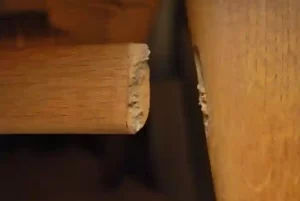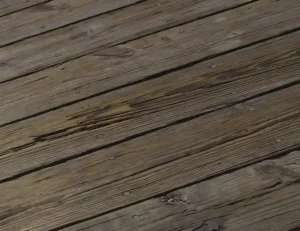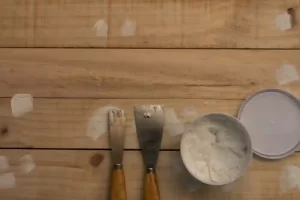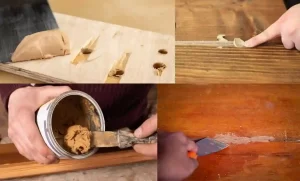Your deck is one of your home’s best assets. It’s the perfect place to host summer BBQs, spend time with family and friends, and relax in the great outdoors. But over time, even the best-maintained decks can start to show their age.
One of the most common issues is splinters and cracks. These can not only ruin the look of your deck but can also be dangerous. Luckily, there is an easy fix: wood filler and paint.
Wood filler is a great way to fill in any cracks or splinters in your deck. It’s easy to apply and dries quickly, so you can get back to enjoying your deck in no time. Plus, it comes in various colors to match any deck stain or paint.
Paint is also an excellent option for repairing cracks and splinters. It provides a protective layer that will help prevent further damage. And, like wood filler, it comes in various colors to match your deck’s existing finish.
So, if you’re looking for the best way to fix splinters and cracks in your deck, wood filler and paint are the perfect solutions. With a bit of time and effort, you can have your deck looking new again.
Why Should You Use Wood Filler and Paint to Fix Splinters and Cracks?
There are a few reasons why you might need wood filler and paints for your deck.
- if you have cracks or splinters in your deck, wood filler for decks is a great way to fill them in. This will help prevent further damage and make your deck safer and more comfortable to walk on. You can also use paint to fill in cracks and splinters.
- Wood filler is also a great way to repair any damage that has already been done to your deck. It can help fill in holes left by nails or screws and even be used to patch up more significant areas of damage.
- If you’re planning on painting or staining your deck, wood filler and paint can help create a smooth, even surface. This will give you the best possible results when it comes to paint or stain.
- Wood filler is also a great way to protect your deck from future damage. You can help prevent water damage, rot, and other issues by filling in any cracks or splinters.
- Finally, Paint or wood filler is inexpensive to keep your deck looking its best. It’s much cheaper than replacing damaged boards and can be done in a fraction of the time.
How to Use Wood Filler and Paint to Fix Splinters and Cracks?
-
The first step is to clean your deck. This will help ensure that the wood filler adheres appropriately. You can use a pressure washer, hose, or even just a stiff brush.
- Once your deck is clean, it’s time to start filling in the cracks and splinters. If you’re using wood filler, simply apply it to the damaged areas with a putty knife or similar tool. For best results, try to match the color of the wood filler to the color of your deck.
- Using paint to fill in the cracks and splinters, simply apply it with a brush or roller. Again, try to match the color of the paint to the color of your deck.
- Once you’ve filled in all the cracks and splinters, allow the wood filler or paint to dry completely. This usually takes about 24 hours.
- Once the wood filler or paint is dry, you’re ready to enjoy your deck again. Just be sure to give it a good sweep before you use it.
Tips for Using Wood Filler and Paint to Fix Splinters and Cracks:
- If your deck is made of pressure-treated lumber, use a water-resistant wood filler or paint. This will help prevent the wood from rotting.
- If you’re using wood filler, smooth it out as much as possible. This will help ensure a smooth, even surface when you paint or stain.
- If you’re using paint to fill in the cracks and splinters, apply a thin layer. This will help prevent the paint from peeling or flaking off.
- Be sure to allow the wood filler or paint to dry completely before using your deck. This will help prevent any further damage.
- Be sure to sweep your deck regularly to keep it looking its best. This will help prevent dirt and debris from accumulating in the cracks and splinters.
Following these tips, you can quickly repair any damage to your deck and keep it looking its best. Wood filler applicator and paint are inexpensive, easy ways to fix cracks or splinters. With a bit of time and effort, you can have your deck looking new again.
Types of Paint and wood filler for deck cracks:
There are a few different types of wood filler and paint that you can use to fix cracks and splinters in your deck.
- Water-resistant wood filler is an excellent option for pressure-treated lumber. This wood filler for deck boards won’t rot or decay, making it perfect for decks.
- Epoxy paint for wood decks is another option for filling in cracks and splinters. This epoxy coating for wood decks is extremely strong and durable, making it perfect for high-traffic areas.
- Paint is also an excellent option for filling in cracks and splinters. Just be sure to choose a paint that’s specifically designed for decks. This will help prevent the paint from peeling or flaking off.
- Stain is another option for filling in cracks and splinters. Just like paint, be sure to choose a stain that’s specifically designed for decks. This will help prevent the stain from peeling or flaking off.
- Finally, wood sealer to prevent splinters is another option for filling in cracks. This wood filler applicator will help avoid water damage and rot, making it perfect for decks.
Whatever type of wood filler or paint you choose, follow the manufacturer’s instructions for the best results.
When to Use Wood Filler and Paint?
Knowing when to use wood filler or paint on your deck is important. If you have small cracks and splinters, you can usually just fill them in with a wood filler deck or paint. However, if the damage is more extensive, you may need to replace the wood splintering damaged boards.
Using wood filler outdoor decking can help prevent further damage to your deck and keep it looking its best. Just be sure to choose the right type of wood filler or paint for the job and follow the manufacturer’s instructions. With a bit of time and effort, you can quickly fix any damage to your deck.
Wood Filler Adhesive: A Way To Treat The Splintered Wood

To use wood filler adhesive, simply apply the adhesive to the crack or splinter. Then, press the wood filler into the crack of the wood splintering. Be sure to smooth out the adhesive as much as possible. Allow the adhesive to dry completely before using your deck.
With wood filler adhesive, you can quickly repair any damage to splintered wood. This type of adhesive is strong and durable, making it perfect for high-traffic areas. Plus, it’s easy to use and won’t take up much time.
So, if you’re looking for the best way to fix cracks and splinters in your deck, use wood filler adhesive. With this type of adhesive, you can quickly repair any damage to your deck.
Wood Filler Alternative: The Best Way to Fix the Splintered Wood
If you’re looking for a wood filler alternative, epoxy paint for wood decks is a great option. This type of epoxy coating for splintered wood decks is extremely strong and durable. It can easily fill in cracks and splinters, making it perfect for high-traffic areas.
To use epoxy paint for wood splintering, apply the paint to the crack or splinter. Then, press the epoxy into the crack or splinter. Be sure to smooth out the paint as much as possible. Allow the paint to dry completely before using your deck.
Epoxy paint for wood decks is an excellent choice for those who want a durable, long-lasting finish. This type of paint can withstand heavy traffic and weather conditions. It’s also easy to apply and comes in a variety of colors.
If you’re looking for a wood filler alternative that’s easy to use and provides a long-lasting finish, epoxy paint for wood decks is a great option.
Frequently Asked Questions:
What is the difference between wood filler and wood putty?
Wood filler is a type of adhesive explicitly designed for repairing cracks and splinters in decks. Wood putty is a type of wood filler used for indoor and outdoor projects.
What can I use instead of wood filler?
If you’re looking for a wood filler alternative, epoxy paint for wood decks is a great option. This type of epoxy coating for splintered wood decks is extremely strong and durable. It can easily fill in cracks and splinters, making it perfect for high-traffic areas.
How big of a gap can wood filler fill?
Most wood fillers can fill gaps up to 1/4 inch wide. Some wood fillers can fill gaps up to 1 inch wide.
Is it better to use wood filler or caulk?
It depends on the size of the crack or gap. For small cracks and gaps, caulk is usually the best option. For larger cracks and gaps, wood filler is the better option.
Can I use spackling instead of wood filler?
Spackling is a type of putty designed to fill small holes in walls. It can be used as a wood filler alternative, but it’s not as strong or durable as epoxy paint.
How do you fill cracks in wood trim?
The best way to fill cracks in wood trim is with epoxy paint. This type of paint is extremely strong and durable, making it perfect for high-traffic areas.
Can silicone be used as wood filler?
Silicone can be used as a wood filler, but it’s not as strong or durable as epoxy paint.
Conclusion:
Wood filler and paint is the best way to fix splinters and cracks in your deck. By using these two materials, you can quickly repair any damage to your deck and make it look brand new again. Plus, this method is much cheaper than hiring a professional to do the job for you. So if you’re looking for a quick and easy way to fix your deck, wood filler and paint are the way to go. Thanks for reading.



 The first step is to clean your deck. This will help ensure that the wood filler adheres appropriately. You can use a pressure washer, hose, or even just a stiff brush.
The first step is to clean your deck. This will help ensure that the wood filler adheres appropriately. You can use a pressure washer, hose, or even just a stiff brush. 
15 thoughts on “Wood Filler And Paint: How to Fix Splinters And Cracks In Deck?”